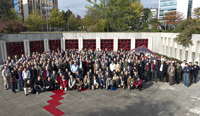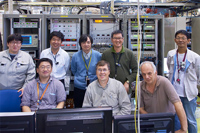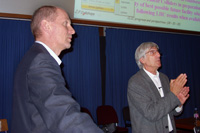Geneva part 2

Impressions from Geneva (click to view photo album). Images: CERN, Nobu Toge and Perrine Royole-Degieux |
As the first in a planned series of workshops, the International Workshop on Linear Colliders had many accomplished missions on the agenda. The ILC, for example, has passed its self-imposed fifty percent mark: half of the nine-cell superconducting radiofrequency cavities produced in the world now reach the desired gradient. The Compact Linear Collider Study (CLIC) has shown that it can generate a high-intensity drive beam by beam manipulation. And both linear collider communities have demonstrated that they get mutual benefit from working together on common issues and meeting once a year to discuss them in plenary.
Read more...
-- Barbara Warmbein |
 |
|
|
 |
| Upcoming meetings, conferences, workshops
2010 IEEE Nuclear Science Symposium and Medical Imaging Conference
Knoxville, Tennessee, USA
30 October - 6 November 2010
SiD Workshop
University of Oregon, Eugene, Oregon, USA
15-17 November 2010
X-Band Structures, Beam Dynamics and Sources Workshop (XB-10)
Cockcroft Institute, Daresbury, UK
30 November - 3 December 2010
Upcoming schools
Fifth International Accelerator School for Linear Colliders
Villars-sur-Ollon, Switzerland
25 October - 5 November 2010
US Particle Accelerator School (USPAS)
Old Dominion University, Hampton, Virginia, USA
17-28 January 2011
|
|
|
GDE Meetings calendar
View complete ILC calendar
|
|
|
 |
"Set it and forget it!"

The S-1 global experiment at KEK's STF with collaborators from Fermilab, working on the compensation of Lorentz force detuning. Image: Nobu Toge |
Fermilab and KEK scientists recently hooked up a new cavity tuning system to the various cavities in the so-called cavity-tuner zoo at KEK. This zoo, comprising eight superconducting radiofrequency cavities fabricated by four different vendors from three different regions, was the testing ground for a new development in what is called Lorentz force detuning (LFD) compensation.
Read more...
-- Leah Hesla and Rika Takahashi |
 |
|
|
 |
From Wired
27 October 2010
Physicists Vote to Run Tevatron for 3 More Years
Right now we have a track record of success. Only in the last year has the Tevatron been in the Higgs game, where we’re able to make statements about the Higgs particle,” Roser said. “It would be a shame to be in that regime and just turn it off.
Read more... |
|
From Popular Science
25 October 2010
Japan's Giga-Sensitive Neutrino Experiment, Modeled In Balloons
British artist Nelly Ben Hayoun has thoughtfully built a 72-foot-long replica of Super-Kamiokande out of Mylar balloons, where guests can sail through the expanse of pseudo-photomultipliers by just shelling out 5 pounds and tugging on a Tyvek protective coverall.
Read more... |
|
From Discover Magazine
25 October 2010
It's full of stars!
The good folks at European Space Agency just released this gorgeous Hubble picture of the globular cluster NGC 1806
Read more... |
|
From RIA Novosti
22 October 2010
Le collisionneur ILC peut être construit en Russie
Lorsque l'on aura tiré les enseignements du travail sur le LHC, lorsque les orientations des recherches à conduire ultérieurement seront claires, on définira les objectifs du futur accélérateur ainsi que les paramètres précis de sa construction, relève Andrey Seryi.
Read more... (in French) |
|
From Times Higher Education
21 October 2010
Spending on pure science 'needs to be protected'
Dr Evans, who led the Large Hadron Collider since its first designs were drawn up in 1993, said keeping the public informed and excited about the project is "part of our job", and he welcomed the media attention it had attracted - even if it had not always been for the right reasons.
Read more... |
|
From Telegraph.co.uk
20 October 2010
Spending Review: Science budget escapes swingeing cuts
The research community, which had been expecting a "catastrophic" 20 per cent cut in grants, said the move was a huge "vote of confidence" for British science.
Read more... |
|
|
 |
 |
|
|
 |
The first joint ILC and CLIC workshop, IWLC10 in Geneva
Today's issue features a Director's Corner from Peter H. Garbincius, Global Design Effort Cost Manager.

Steinar Stapnes (left) and Jean-Pierre Delahaye answering questions on CLIC R&D programme. Image: Peter Garbincius |
The International Linear Collider community has typically held major meetings twice a year where the accelerator and physics & detector people come together, both to review the status of and make progress in their own disciplines, and to work together in areas of mutual concern, such as the beam and luminosity requirements to attain the desired science goals. This year, the International Workshop on Linear Colliders (IWLC2010), organised by the European Committee for Future Accelerators (ECFA), was noteworthy in that it was the first joint workshop for both ILC and CLIC – an electron-positron Compact Linear Collider Study based on room-temperature radio frequency technology operating at three teraelectronvolts (TeV) – including the accelerator and detector & physics groups for both the ILC and for CLIC.
Read more...
-- Peter Garbincius
Director's Corner Archive |
 |
|
|
 |
ILC Internal Document
2010-049
Project Managers’ Report - August and September 2010
arXiv preprints
1010.4633
Single production of the doubly charged Higgs boson via eγ collision in the Higgs triplet model
|
|

